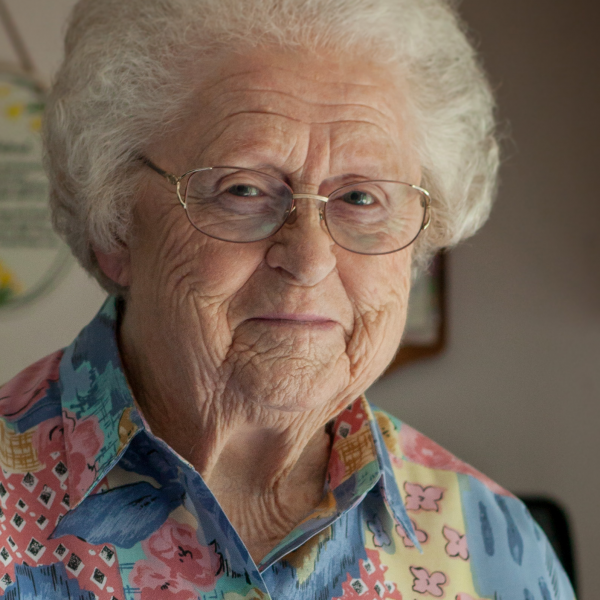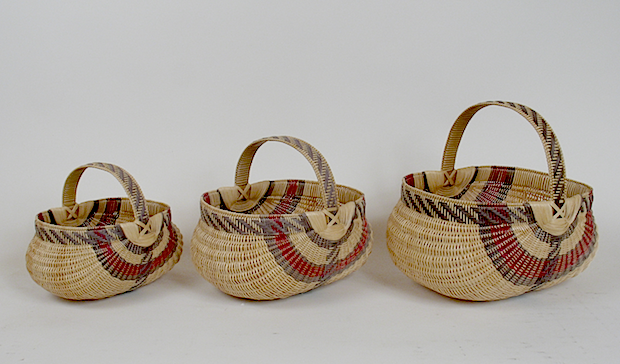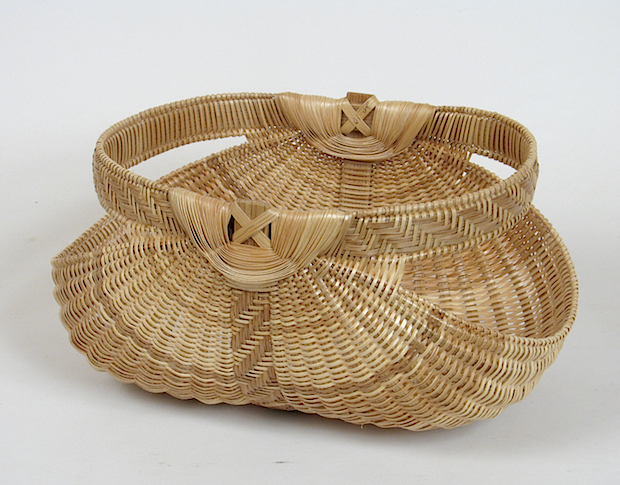Leona Waddell

Photo credit: Clinton Lewis/WKU
Bio
“You know, I've always thought that if you're going to make a basket and put that much work in it, you want to do it as neat as you can, the best you can.”
A revered leader in the white oak basketmaking community, Leona Trulock Waddell is a master artist whose basketmaking skills have been perfected by her years of experience and exemplify the interaction of tradition and innovation, as she both maintains the traditional form of the region’s baskets and puts her own personalized evolving imprint on each one.
Waddell was born in 1928, in Cub Run, Kentucky, a small rural community at the edge of what is now Mammoth Cave National Park, known as the epicenter of white oak basketmaking in the south central area of the state. Growing up on a farm during the Depression, she learned by an early age that basketmaking was essential to providing for the family in a subsistence-based household. By age ten Waddell began learning from her masterful mother, Ella Mae Puckett Trulock, who concluded that she, out of all her children, had a real “talent for it.”
After marrying in 1945 and raising a family, Waddell returned to the art form she loved after her oldest daughter was born. Over the past half century, the white oak baskets she creates have changed radically from the less-refined market baskets she made in her youth to intricately woven creations owned by basketmakers and collectors throughout the world.
In South Central Kentucky, the basketmaking material of choice has remained the white oak tree for generations because of the wood’s superior qualities, including workability, durability, and aesthetic appeal. For years Waddell’s practice began with hiking the forests, selecting the perfect tree, splitting the log by hand, and meticulously scraping and trimming her white oak splits. She has taken the utilitarian form and refined it, and her baskets display painstaking uniformity and precision. Today, Waddell takes great pride in her position that cherishes her work as both a detailed innovator and a historical exemplar of the tradition.
In addition to her own basketmaking, Waddell ensures that the tradition lives on through education and public presentations. She has served as a master artist in the Kentucky Arts Council’s NEA-supported Master Folk and Traditional Arts Apprenticeship Program, demonstrated at festivals and community events, and consistently wins multiple prizes at the annual Hart County Fair basket competition. In 2008-2010, Waddell was a featured artist in Tradition/Innovation, American Masterpieces of Southern Craft & Traditional Art, a touring exhibit produced by South Arts. Most recently she was honored as the recipient of the 2012 Kentucky Governor’s Award in the Arts Folk Heritage Award for her outstanding effort to perpetuate and promote Kentucky’s unique artistic traditions. In 2013, Waddell’s work was included in the Smithsonian American Art Museum and Renwick Gallery exhibit A Measure of the Earth: The Cole-Ware Collection of American Baskets and the National Basketry Organization presented her with its highest honor, its Lifetime Achievement Award.
Bio written by Brent Bjorkman, Kentucky Folklife Program, Western Kentucky University


2016 Interview with Leona Waddell by Josephine Reed
Edited by Kathryn Brough
NEA: When did you first learn to make baskets?
Leona Waddell: Well, I first learned by helping my mama. I was about ten years old. And I helped her off and on till I was about 17, almost 18. She sold them for money, and then she exchanged them for clothing from different states.
NEA: What kind of baskets did you make with your mother?
Leona Waddell: She made picnic and laundry baskets. They were huge baskets. And she made fireside baskets, they call them. They have a flat bottom, and then they join up to the handle.
NEA: When did you start making baskets again?
Leona Waddell: After I married, I didn't make any for several years. I helped on the farm. Cut tobacco and shucked corn, whatever there was to do. And then when my daughter was three months old, I made market baskets, and I got 65 cents apiece. I thought that was real good, you know?
NEA: When you started weaving again, did you like it? Had you missed it? Or did it just seem like a sensible thing to do?
Leona Waddell: I worked at school and one year, I guess we were on spring break or something, and I went down to my mom's. She was still living, and she was about 83 at that time. And she still was making them. So I went down to visit her that week, and then I got into it and made three magazines that week. You made a big round thing, and then you put a handle in it and folded it up. They called them magazines back then. So I made three of those that week. And I came, and I said, "I just kind of got the fever, you know, to get back in them." So I started then making egg baskets.
NEA: How long would it take you to make a market basket?
Leona Waddell: I think I'd make maybe a couple a week. With keeping house and [my daughter] was little. And I had a son. He was four years older than her.
NEA: When you first learned to make baskets, did you like it right away?
Leona Waddell: Well, I never thought nothing about it. I was just getting it done, you know? When I started, I liked to finish them.
NEA: Were they always made out of white oak?
Leona Waddell: Yes. You don't find it very much anymore, because older people just about cut it all out, and it's not grown too much. In some places, there're not any. But hopefully, we think we've found some that we'll get when we get back home.
NEA: And why do you like white oak?
Leona Waddell: I guess because it's a hardwood when it seasons. You can't whittle it. You can take a knife and try to cut it, it just slips on over it. It's that hard. It lasts forever.
NEA: Can you describe what goes into making baskets? How do you begin?
Leona Waddell: Well, you have to cut the tree first. You have to have a sledge hammer, wedges, axes. And you split the tree in half, and then you split the half, that makes a quarter. And then you split that, and then you take the heart out—the hard part of the tree. And then you generally split that again, until you can work it down with your hands with a knife. It's a lot of whittling. It's all whittled out by hand.
This timber has a grain in it, and you follow those grains. And you split them open until you get them thin enough, thin as you need them, and then you have to scrape them down slick.
NEA: It is amazing to see how much work goes into it before you even begin to weave.
Leona Waddell: You’ve got to whittle it all out. You've got to whittle the open end and make that. And then you got to put that together. And then you got to measure and see how long you have to have your ribs. And then you got to whittle out 24 ribs. Twelve flat ribs, and twelve round ribs. And you stick these flat ones in first, and then you weave it a little bit, and then you can start putting the round ones in two at the time. Then you separate them until you get it all the ribs in. And then you weave it to get it all finished out.
NEA: What makes Hart County, where you're from, baskets so unique? What makes the baskets that you do in your part of the country so different from others?
Leona Waddell: Well, I think I take more pains with them. And more time. It takes time and patience. And if it doesn't look like I want it, it's ripped out and redone.
NEA: When you were teaching, what did you want to teach your students about making baskets? What do you think was the most important lesson?
Leona Waddell: Well, I wanted to teach them to make them like I made them. Not just anything will do.
NEA: You have won First Place or Best of Show at the Hart County Fair for years and years.
Leona Waddell: Twenty-seven years.
NEA: That's quite a record. Do you remember the first one, the first basket?
Leona Waddell: Well, I don't actually know how I got started. But I made one and took it. So I won First Place with that one. And then that kind of got me started going to the fair every year. And next year, I had maybe two. And then one year, some guy from Frankfurt wanted some of my baskets. They hadn't even judged them yet, and this guy talked to me and my granddaughter, and then he left, and I thought he left for good. Well, then he comes back and he has the money, and he buys the baskets and they hadn't even been judged. I didn't know how the program was at that time. So he paid me for the baskets. Dr. Middleton generally buys all the First Prize baskets and the doctor's wife, she kind of got angry, because I didn't have them. "But we would have paid you more than that for them," she told my granddaughter. And so after that, I just waited until they were judged and then let them buy what they wanted and see if anybody else wanted them if I had any left.
NEA: What does the National Heritage Fellowship mean to you?
Leona Waddell: Well, it means a lot of things. It's one thing I'm proud that I stuck with the baskets. And I'm glad that people want my baskets. And I'm glad I have taught a few that I would hope keep it up.
NEA: Do you think the award in some ways will make people more interested in basket weaving?
Leona Waddell: Well, I would think it would, you know? You can't tell, but it's hard work. And it's like I said, if you do it right, it takes time and patience. And it depends on the type of timber you have.

